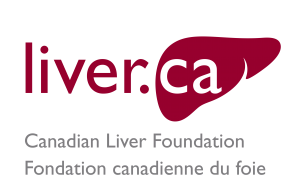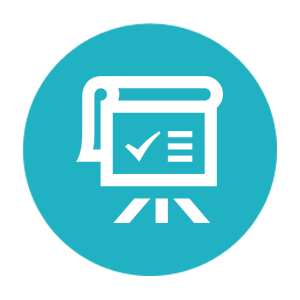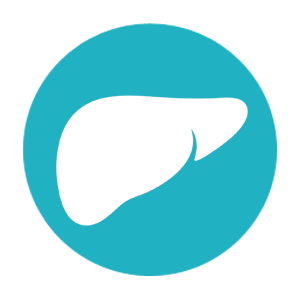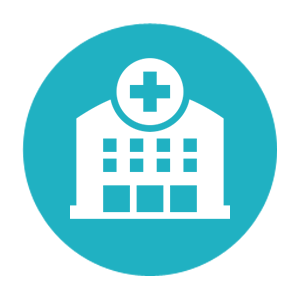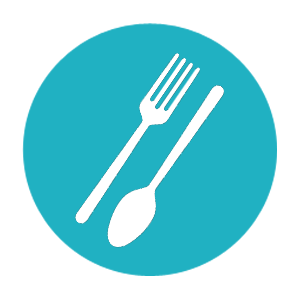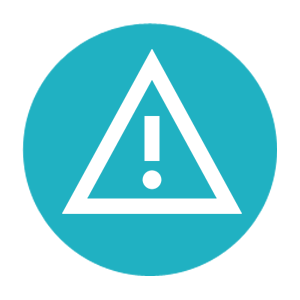Liver Health Month-Check Your Engine

Your liver is your body’s high-performance engine
Some car owners sink their time, money and effort into caring for their high-performance vehicle. Others care only the bare minimum, ignoring the oil leaks, the spreading rust or the concerning noises, just hoping that it will always start up in the morning.
Your liver is your body’s engine, and the reality is that when your liver stops and breaks down, your body does too.
Your liver requires high-quality fuel, regular maintenance, hazard protection and some loving care. Filling up your liver with the wrong stuff and leaving it idle for too long can cause liver diseases like non-alcoholic fatty liver disease (NAFLD) to develop.
NAFLD is a liver disease which starts with fat accumulation in the liver without excessive alcohol consumption. Despite it affecting over 7 million people in Canada, close to 90% of Canadians report having little to no knowledge of the disease ever before. Unfortunately, if left untreated, NAFLD may progress to more advanced disease, such as non-alcoholic steatohepatitis (NASH). The good news is that NAFLD can often be prevented or even reversed if it is detected before permanent liver damage has occurred.
The Canadian Liver Foundation would like to share critical ‘engine’ information with you, so that you can take a detour towards liver health!
Non- Alcoholic Fatty Liver Disease
Stéatose hépatique non alcoolique
Your Liver
Votre foie
Stats: 1 in 4 Canadians may be affected by liver disease.
The obesity crisis is taking its toll on the liver with potentially deadly consequences. Research shows that 1 in 4 Canadians may be affected by liver disease due primarily to the rapidly rising prevalence of non-alcoholic fatty liver disease linked to obesity, lack of physical activity and poor eating habits. This progressive disease is predicted to overtake hepatitis C as the leading cause of liver transplants.
Ipsos Survey (English)
Ipsos Survey (French)
An Ipsos survey conducted by the Canadian Liver Foundation revealed that;
- Nearly two-thirds of Canadians consider themselves as ‘overweight.
- Just 34% of Canadians state they have ‘very healthy’ eating habits.
- 62% of Canadians do not exercise enough to meet Canada’s recommended guidelines for physical activity on a regular basis.
Don’t let liver disease get in your way, read more and take a detour towards liver health!
Liver Health
- Your liver is the body’s largest internal organ, weighing in at about 3 pounds.
- At any one time, your liver contains about 10% of the blood in your entire body, pumping about 1.4 litres per minute.
- Your liver can regenerate, making it possible for one person to donate part of their liver to another. This is called a “living donation.”
- Within the first few months of a living liver donation, the liver can regenerate to within 90% of its original size.
Liver Disease
- There are over 100 liver diseases; only one is caused by alcohol.
- Non-alcoholic fatty liver disease (NAFLD) is the most common liver disease in Canada.
- Biliary atresia is the leading cause of liver failure in children.
- Acetaminophen (Tylenol) overdose is the leading cause of acute liver failure.
- Liver cancer is now one of the fastest rising and deadliest forms of cancer in Canada.
- Over half a million Canadians suffer from chronic viral hepatitis.
NAFLD/NASH
- NAFLD affects over 7 million Canadians and is expected to rise.
- Children as young as two years old can be affected by NAFLD.
- Up to 90,000 NAFLD patients can develop liver cancer.
- Up to 11 percent of NASH patients may die due to liver failure.
- Up to 20 percent of obese individuals in Canada have NASH.
Fat Destroyed Her Liver, A Transplant Saved Her Life

My name is Debbie Kleiboer. In the summer of 2010, I was diagnosed with non-alcoholic fatty liver disease (NAFLD), the most common liver disease in Canada. In a short period, my life changed completely. Over the next two years, my condition deteriorated so much that I needed a liver transplant. Thankfully my brother David was a match, and I received my gift of life on April 18, 2012.
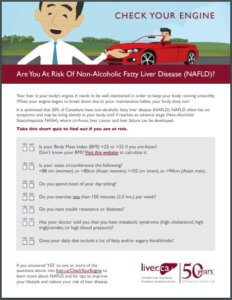 NAFLD/NASH
NAFLD/NASH
It is estimated that 20% of Canadians have non-alcoholic fatty liver disease (NAFLD). NAFLD often has no symptoms and may be living silently in your body until it reaches an advanced stage (non-alcoholic steatohepatitis, or “NASH“), where cirrhosis, liver cancer and liver failure can be developed.
This Liver Health Month, take a short quiz to find out if you are at risk. (English) or (French)
Back to top
Taking a look under the hood
 Your liver, the largest internal organ in the body, is located in the right upper quadrant of the abdomen, immediately under the diaphragm. It is divided into lobes; a large right lobe and a smaller left lobe that tapers to a tip.
Your liver, the largest internal organ in the body, is located in the right upper quadrant of the abdomen, immediately under the diaphragm. It is divided into lobes; a large right lobe and a smaller left lobe that tapers to a tip.
Your liver works hard 24 hours a day, providing your body with energy, fighting off infections and toxins, helping clot the blood, and regulating hormones. If you thought that was enough, consider that this complex and vital organ performs over 500 functions.
Every day your liver…
- Regulates your supply of body fuel by producing, storing and supplying quick energy (glucose) to keep your mind alert and your body active.
- Adjusts your body’s cholesterol levels by producing, excreting and converting cholesterol into other essential substances.
- Produces bile to eliminate toxic substances from your body and assist with your digestion.
- Controls your body’s supply of essential vitamins and minerals as well as iron and copper.
- Cleanses your blood by metabolizing alcohol, drugs and other chemicals.
- Neutralizes and destroys poisonous substances.
- Manufactures many of your essential body proteins which allow for your body to transport substances in your blood, the clot your blood and resist infections.
- Regulates the balance of hormones including sex, thyroid, cortisone and other hormones.
- Performs hundreds of other functions that your body simply cannot live without.
When your engine stalls…
The liver is a resilient, maintenance-free organ, which is why it so often gets ignored—until something goes wrong. Because of its wide range of responsibilities, the liver often comes under attack by progressive diseases like obesity, viruses, toxic substances (including alcohol) and contaminants.
Just like a worn-out engine, symptoms of liver disease can seem minor and easy to ignore. The liver is such a strong organ that it will continue working even when two-thirds of it has been damaged by scarring (cirrhosis).
The good news is that some liver diseases can often be prevented or even reversed if detected before permanent liver damage has occurred. You and your family can make lifestyle changes to prevent NAFLD.
Encouraging your family to take walks together or parking a little further from the grocery store entrance are great places to start. Eating foods that are low in saturated (animal) fats, as well as plenty of fresh fruit and vegetables and limiting consumption of sugary foods and drinks are all long-term goals that can make a tremendous impact on your liver health.
What is liver disease?
Liver disease consists of over 100 different forms and can be caused by a variety of factors including obesity, alcohol, genetics, autoimmune disorders, drugs, toxins, hepatitis viruses and cancer. Cirrhosis is often considered to be a liver disease and may be the only liver-related condition that many people have ever heard of. While not a disease, cirrhosis is a condition that results from permanent damage or scarring of the liver. It is the end stage of many forms of liver disease.
Statistics show that liver disease is on the rise. 1 in 4 Canadians may be affected by liver disease, including everyone from newborns to older adults. Liver disease can affect people from all walks of life regardless of age, sex, ethnic background, socio-economic status or lifestyle.
Non-alcoholic fatty liver disease (NAFLD) begins when fat builds-up in the liver of someone who drinks little to no alcohol. The extra fat and sugar from the food we eat are stored in the liver as fat cells, making the liver more vulnerable to injury. The most severe form of NAFLD is called non-alcoholic steatohepatitis (NASH), which occurs when the liver starts to get inflamed and can lead to cirrhosis (scarring), liver cancer, the need for a liver transplant over even death.
The most common cause of NAFLD in Canada is obesity, and it can develop in children as young as two years old. In general, people with NAFLD have no symptoms, with very few reporting ‘flu-like symptoms’ or discomfort in the right-upper side of their belly.
There is currently no drug available to treat NAFLD. However, leading a healthy lifestyle with proper diet and activity habits have been shown to reverse the disease if detected early and not significant damage has occurred. A healthy lifestyle can also prevent your risk of developing NAFLD in the first place.
Just like a car engine, significant damage to your liver can be masked by seemingly insignificant symptoms. This often makes it difficult to diagnose liver diseases, especially when some symptoms (if any), can easily be mistaken for other health problems, such as the flu.
Your doctor or “mechanic” may look for signs of liver disease such as yellowing of skin or whites of the eyes (jaundice), a swollen belly or tenderness in the area of the liver.
They may use blood tests to determine if your liver is functioning correctly and to discover what may be affecting your liver.
In the case of non-alcoholic fatty liver disease (NAFLD), two other methods are used to help indicate its existence. Calculating a patient’s Body Mass Index (BMI) will determine if you are at an unhealthy weight due to your height and weight (though it varies for different ethnic groups). Another critical indicator would be the size of your waist. Many people with NAFLD carry a lot of fat around their midsection.
Every day you make decisions that affect your liver health. The choices you make on household product purchases, food consumption and daily activity can have positive or negative effects on your liver.
If your doctor suspects that you may have liver disease, he/she will want to discuss any possible risk factors to which you may have been exposed. These risk factors may include:
- Poor eating habits.
- Sedentary lifestyle.
- Other medical conditions like diabetes, high blood pressure and insulin resistance.
- Prescription or over-the-counter drug use.
- Past blood transfusions.
- Occupational exposure to blood.
- Exposure to toxic chemicals.
- Body beautification (tattoos, piercings, etc.).
- Sexual activity.
- Current or past use of injection drugs.
- Alcohol consumption.
- A family history of liver disease.
- Being born in or travelling to a country with high rates of viral hepatitis.
- Being born between 1945 and 1975.
Learn more about different risks and what you can do to keep your liver safe.
Five Years And 100 lbs. Ago, Leigh Had Never Heard Of NAFLD
 He was fortunate that his doctor did bloodwork when he came in complaining about a pain in his side that he thought was just a pulled muscle. Tests showed elevated liver enzymes, and after a referral to a liver specialist, he was diagnosed with non-alcoholic fatty liver disease (NAFLD).
He was fortunate that his doctor did bloodwork when he came in complaining about a pain in his side that he thought was just a pulled muscle. Tests showed elevated liver enzymes, and after a referral to a liver specialist, he was diagnosed with non-alcoholic fatty liver disease (NAFLD).
Preventative maintenance and operating tips
Put these key tips into the ignition and get on the road to a liver healthy life! Incorporating these easy everyday tips on nutrition, daily activity, exercise and sleep can help decrease your risk of NAFLD/NASH and increase your chances of feeling more energized and less stressed!
Nutrition
A change in diet plays a significant part in how NAFLD may be treated and certainly how it can be prevented. Consuming too much sugar and saturated fat in your diet can have a similar effect as too much alcohol—fat build-up in the liver. Although there is no specific ‘liver healthy diet,’ these general guidelines of what and how much to eat can help ensure that your liver is functioning at its best!
- Eat small regular meals. Do not skip meals or over-eat.
- Drink 6 to 8 glasses of fluids (preferably water) a day.
- Regularly choose a variety of whole foods including fruits and vegetables, protein sources (legumes, lean meats), whole grains (quinoa, wild rice), dairy (low-fat yogurt, milk and cheese) and sources of healthy fat (nuts, avocado, fatty fish).
- Increase your intake of fresh fruits and vegetables, especially brightly coloured ones with deep bright pigments such as oranges, yellows, reds and greens. Fruits and vegetables are high in antioxidants, which are vital for overall liver health.
- Maximize consumption of raw vegetables with high sulphur content (i.e. broccoli, Brussels sprouts, cabbage, cauliflower, garlic and onions).
- Wash fruit and vegetables right before use to remove pesticides. Avoid washing too far ahead to reduce sweating or spoilage.
- When cooking vegetables and fruits, steam or bake them. This retains more nutrients than boiling.
- Moderate your consumption of saturated fat and simple sugar, as high intakes of sugar (fructose) sweetened beverages and fatty foods high in saturated fat have been associated with an increased risk for developing a fatty liver.
- Drink black coffee (two to three cups a day). Studies have shown this may help improve or protect the liver from some diseases.
- Consume vitamin D fortified dairy products, and vitamin D fortified plant-based foods to ensure your vitamin D needs are met. This is important to promote liver health and a healthy body weight.
- Choose whole-grain products over white/bleached/refined products.
Physical Activity
Recognizing the difference between physical activity and exercise is the first step to living a lifestyle filled with more movement! While exercise is something best done with a moderate to high intensity and a structured routine, the goal of physical activity is do anything you can that gets you moving and can be physically demanding.
- Consider completing chores or running errands like cleaning, shopping, mowing the lawn/gardening or shoveling snow.
- Use ‘active transportation’ to get where you need to go, whether that includes walking, biking or running instead of driving.
- Limit the screen time of you and your loved one as much as possible (experts suggest two hours a day for children)
- Set an example with your family. If you have kids, walking to or from school or the store.
- Park a little further away when going shopping.
- If you work a desk-job, take small and frequent breaks to stretch.
- Consider also creating opportunities to walk during your lunch break, or before/after work.
- Encourage your family to take part in a physical activity together, like bike riding, hikes or walks around the neighbourhood.
Remember: Make sure you or your loved one stay hydrated, even during physical activities. Carrying a water bottle during any physical activity is recommended.
Heading home after a long day, most of us would just like to rest, relax and rid ourselves of stress. The last thing on the mind may be getting some exercise. But did you know that eating a ton of fatty or sugary foods and not getting enough physical activity puts stress on your liver? To continue reading click here
Sleep and Your Overall Health
If you were to weigh how important sleep is to your liver health, how far high up or down would it fall on the list? Sleep affects so many parts of life like our mental health, and it should be valued just as much as eating right and getting enough physical activity throughout the day. Many Canadians do not get enough sleep, and the impact can be seen on their liver health.
Insufficient sleep has been linked to a number of poor physical and mental health concerns, including an increased risk for developing a fatty liver. Lack of sleep can contribute to changes in your overall metabolism (like insulin resistance) that may affect the way your liver converts nutrients from the foods you eat, making it harder to maintain a healthy body weight. It can also make you feel more tired and sleepy during the day which also affects your overall physical activity level.
Health Canada recommends that getting at least 7-9 hours of sleep per night for adults is essential to maintain your health. Children need even more sleep time. Current guidelines recommend 9–11 hours of sleep per night for children ages 5–13 years old, and. 8–10 hours of sleep per night for children 14–17 years old.
Sleeping the recommended hours isn’t the only recipe for obtaining a healthy ‘sleep routine.’ It is also important to maintain a good pattern of sleep without interruptions that may prevent you from getting a good rest.
- Be consistent. Go to bed at the same time each night and get up at the same time each morning, including on the weekends
- Make sure your bedroom is quiet, dark, relaxing, and at a comfortable temperature
- Limit accessing, watching or playing on electronic devices, such as TVs, computers/tablets, and smartphones, prior to sleep time.
- Avoid large meals, caffeine, and alcohol before bedtime
- Get some exercise. Being physically active during the day can help you fall asleep more easily at night.
Lack of sleep can be due to a condition called sleep apnea. If you snore loudly and feel tired even after a full night’s sleep, you might have sleep apnea. One of the most common types of sleep apnea is obstructive sleep apnea, caused by your throat muscles relaxing and affecting the way air enters your lungs.
Common signs and symptoms of sleep apnea include snoring while sleeping, waking up gasping for air several times a night, morning headache, irritability and feeling sleepy during the day. If you think you may have any of these symptoms, speak to your doctor or health care provider.
Hazard protection
Just like a vehicle, your liver can come under attack from all sorts of contaminants, chemicals, toxins and other aspects ready to slow you down. Also like a car, modern medicine has allowed us to take precautions and avoid these hazards by staying informed and up-to-date with some of these suggested tips.
- Avoid contaminants. The cleaner your engine, the better it runs. Since your liver has to filter out all the contaminants that enter your body through what you consume, breathe in or rub on your skin, you should try to avoid harmful substances.
- Prescription and non-prescription drugs, alcohol and certain chemicals can damage your liver if misused.
- Protect yourself from hazards. Air filters, fluids and regular maintenance help protect your vehicle from both wear and tear and environmental hazards. You can protect your liver in similar ways.
- Get immunized against hepatitis A and hepatitis B, practice safe sex, never share razors, toothbrushes and needles (which can spread hepatitis B and C through blood), and make sure tattooing and body piercing equipment are properly sterilized.
Warning Lights
Prevention is the best way to ensure your liver is functioning at peak performance. Be sure to see your doctor for regular checkups so she/he can identify potential problems before they start. Take extra care by asking your doctor for a liver test.
Your vehicle is equipped with various warning lights to indicate when there’s a problem. Unfortunately, your liver’s warning lights may not be as clear. Signs of liver disease can often be misinterpreted, such as flu-like symptoms, fatigue, or lack of appetite. If you have any of these symptoms and/or abdominal pain, dark urine, or jaundice, consult your doctor.
Regular visits to your mechanic will help keep your vehicle running well.
Are you looking for a health care provider? Here’s how we can help.
What can you do if you have liver disease?
- Follow your doctor’s advice on nutrition, exercise and other lifestyle choices.
- Learn about liver health and what you can do to manage your condition.
- Call the Canadian Liver Foundation (CLF) support line for resources and clarification on your diagnosis.
- Join the CLF Peer Support Network, a national group of people living with liver disease who volunteer to share their experiences with others.
- Contact the CLF in your area to get involved.
Join us on our efforts to increase awareness of liver health, and help us continue bringing liver research to life. Here is what you can do:
